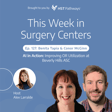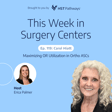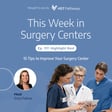
Mike Tompkins – The Magic of Automatic Payment Posting
Mike Tompkins is a Client Services Manager at in2itive, and we had a chance to talk through the intricate world of payment posting in ASCs, mainly focusing on commercial payers. If this is still a manual process for you and you are spending time reconciling payments on the backend of your billing system, then you’ll learn a lot in this episode about how automating those processes can improve the accuracy and efficiency of the entire billing process and get you paid faster.
In our news recap, we’ll cover some preliminary findings from Avanza Healthcare Strategies’ Hospital Leadership ASC Survey, what HCA shared at their investor day, how to prepare for OAS CAHPS, and, of course, end the news segment with a positive story about a nurse who saved a man’s life on the side of the road.
Articles Mentioned:
ASC ownership is shifting: What leaders need to know
HCA outlines plans to expand market share by 2030
Patient Experience Survey to Become Mandatory Soon
Approved OAS-CAHPS Survey Vendors
NJ ICU Nurse Joyce Park Saves Life of Car Accident Victim
Brought to you by HST Pathways.



















